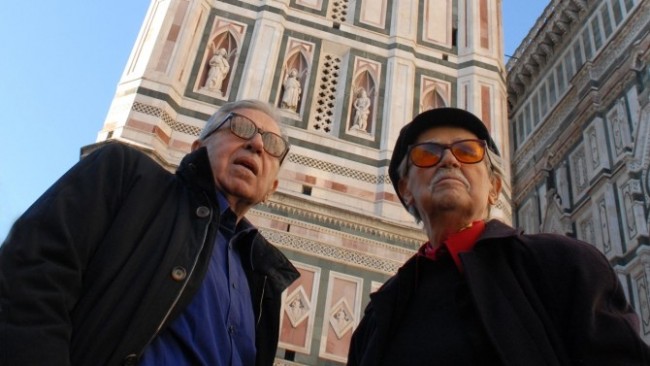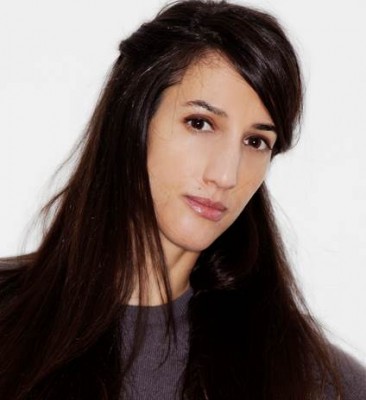From Variety, Monday, January 25:
Italy’s Taviani Brothers On Selected Works And What A Gentleman Ettore Scola Was (EXCLUSIVE)
By Nick Vivarelli, International Correspondent
Italy’s revered filmmaking duo, the Taviani Brothers, Paolo and Vittorio, emerged way before the Coens, the Hugheses and the Wachowskis and are amazingly still active, well in their 80’s. They spoke, in unison, to Variety about their three classics “Padre Padrone,” “Night of the Shooting Stars,” and “Kaos,” which will screen in L.A. as part of a Taviani tribute, and also about their more recent works “Caesar Must Die,” the 2012 Berlin Golden Bear winner, and “Wondrous Boccaccio” which opened the Beijing fest last year. The Taviani tribute will be presented Jan.29–Feb.4 at the Ahrya Fine Arts Theatre by Cohen Media Group’s Classics of Cinema Film Collection.
It’s well-known that Rossellini loved “Padre Padrone.” He presided the Cannes Jury that awarded it the Palme d’Or in 1977. It’s also known he was a great inspiration to you when you were both very young. Can you talk to me a little about that?
We were high-school students in Pisa. We walked into a movie theatre called Cinema Italia, which no longer exists, and there was a film playing called ‘Paisà’ that we had never heard of. There were only a few people there, and when we saw these images they really blew our minds. We had experienced the war as kids, and very deeply. But what we were seeing on screen made that reality so much clearer for us. This movie was telling us things about ourselves that we did not know. So we said to ourselves: ‘If cinema has this strength, this power to reveal to ourselves our own truths, then we will make movies!’ We decided to become filmmakers right there, on that day. Years later, when we went to Cannes with “Padre Padrone,” the thought that we had started making movies thanks to Rossellini and that he was awarding us the Palme d’Or was for us like the closure of a splendid luminous circle. It’s an extraordinary memory.

The other big contender that year for the Palme was Ettore Scola’s ‘A Special Day’. There was a very heated debate over whether Scola’s film should have won the prize instead of yours. Did you ever talk with Scola about this?
Rossellini believed in a certain type of cinema. When he found films that explored new roads that fascinated him, as was the case with ‘Padre Padrone’, he really wanted to make a statement to support them. Ettore sent us a telegram which read: ‘The best film has won,’ I must still have it somewhere. He was very affectionate and kind. When we talked about it, he said: ‘That’s what Rossellini is like.’ He was very generous about it. What happened is that Scola’s extraordinary film – his greatest – was sacrificed on the altar of the type of cultural statement that Rossellini wanted to make. When we talked about this with Scola, that is what we would always say to each other.
Like “Paisà” “The Night of the Shooting Stars” is about World War Two. But it is also autobiographical and has fablelike and poetic aspects. I know you worked on this film with the great Tonino Guerra, who besides being a screenwriter was a poet.
We went to Tonino, who we had known for years, with an already written screenplay. He read it, really liked it, and then we started talking. That’s how we worked. He would read our script and say things, some of which were extraordinary and some of which were not, in which case he would say: ‘ok, I take that back.’ It was a marvellous relationship, but not in terms of strict writing. We would always write the screenplays first and then have these dialogues with him that brought us extraordinary poetic ideas.
Of course you also worked with Guerra on “Kaos,” which was based on Pirandello.
After “The Night of the Shooting Stars” we went to Tonino and said: ‘Tonino, we have a new idea: we want to do these Pirandello short stories’ He said: hold it! You guys are crazy. After what you’ve achieved with ‘Padre Padrone’ and ’Shooting Stars’ you want to put yourselves under Pirandello’s heel, but he’s going to crush you. I refuse to work on this. It’s a mistake. So we decided we would think about it. A few days later we went back to him and said ‘we’re doing Pirandello’ And he said: ‘great! I was just testing you guys. I wanted to see how determined you were.’ And so we started working.
Many years later you made “Caesar Must Die,” which is about high-security inmates acting Shakespeare and won the Golden Bear at the 2012 Berlin fest. How did that come about?
We were invited to see a play at the Rebibbia jail in Rome, and we were shocked and awed. That day an inmate with a life sentence was reading a canto from Dante’s Inferno: He said: ‘I don’t think anybody in this room can understand this verse the way we do. We know what it’s like not be able to love a woman. His passion as he read Dante in Neapolitan dialect was such that we turned to each other and were both crying. And we said: ‘we have to make a film about this!’
One thing that I found really interesting about your latest film: “Wondrous Boccaccio,” an adaptation of “The Decameron,” is that it opened the Beijing Film Festival last year. Also I wonder: what was it like going from jail cells to Boccaccio?
The film was hugely successful in China. In talking to film students there we realized that in China they love historical and fantasy movies. As for why Boccaccio? Actually the two films spring from the same emotions. In jail there is horror and suffering, so Dante or Shakespeare really speak to them and when they act they put all their passion into it. Thanks to Shakespeare they save themselves. It’s like a mass escape. Art saves them, even if only for a moment. In “The Decameron” it’s the same thing. There is the plague, horror, suffering, desire to survive. How do these young people survive? Telling each other stories. For a few days they manage not to think about death, or to think about it only sporadically.

